Physical Address
304 North Cardinal St.
Dorchester Center, MA 02124
Muscle comes in three varieties:
Cardiac
Skeletal
Smooth
These three types are differentiated based on:
Distinct control systems (neuronal, neurohormonal)
Anatomic locations
Specialized cellular structure, function, and biochemistry.
The major function of skeletal muscle is its role as the effector organ in voluntary movement. It mediates transformation of central nervous system electrical activity into purposeful mechanical actions, such as maintaining posture, moving limbs and digits, and speaking. In addition, it has secondary roles:
Potential source of metabolic energy. In cases of stress, such as starvation, skeletal muscle tissue can be catabolized (broken down) to provide energy.
Contributes to body heat generation.
The precise control of muscle activity by the nervous system is necessary for effective reflexive and conscious movement. This chapter focuses on its neuronal control of muscle, whereas the discussion of the molecular basis of the contractile machinery and the distinctions between different types of muscle will be covered in Chapter 6 .
Three organ systems are involved in movement:
Nerves (including the brain and spinal cord)
Muscles
Bones
This chapter will discuss nerves and their interface with muscles at the neuromuscular junction. Although bones have their own physiologic functions and regulatory systems (see Ch. 33), we will currently only discuss them as scaffolding.
Although most conscious movement requires input from the brain, reflexive movements require only the spinal cord and the skeletal muscles.
The central nervous system is composed of the brain and the spinal cord.
Higher areas of the brain generate instructions for purposeful, conscious movements and modify lower systems that carry out unconscious movements and reflexive muscle contractions.
The spinal cord performs two critical functions:
Carries information in two directions: sensory input from periphery to the brain, and movement instructions from the brain to periphery.
Simple reflex movements requiring no input from the brain.
Skeletal muscles are found throughout the body connected to bones via tendons.
Collectively, skeletal muscles make up 45% to 50% of total body mass.
Skeletal muscles receive variable percentages of cardiac output depending on the activity level.
Various sizes and shapes of skeletal muscles correlate with their skeletal attachments and motor functions.
Tissues important in the generation and tailoring for movements include specific areas of the brain and spinal cord, as well as the skeletal muscles.
Fig. 5.1 A illustrates some of the brain tissues involved in the generation and transmission of motor instructions.
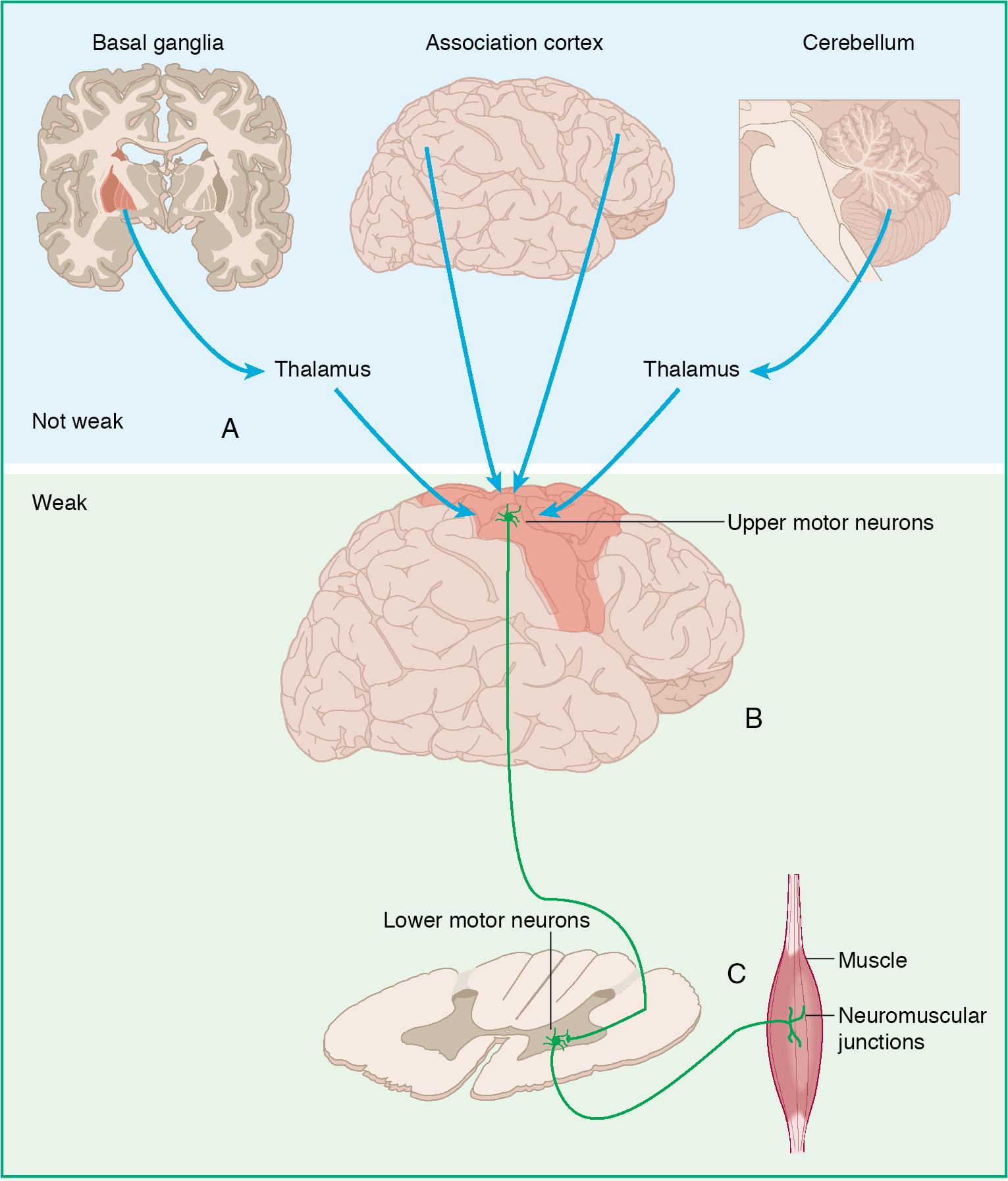
The premotor cortex and supplementary motor area are located in the frontal lobe.
The premotor cortex receives input from the cerebellum, which provides important signals regulating balance and coordination.
The supplementary motor area receives input from the basal ganglia, a complex subcortical tissue involved in the prioritization of movement programs and their components.
In addition, both the premotor cortex and the supplementary motor area are connected to networks of sensory and association neurons that provide information important for planning and executing movements.
The primary motor cortex is a strip of frontal lobe cerebral cortex that receives input from the premotor cortex, the supplementary motor area, the cerebellum, and higher sensory and association areas of the brain. The primary motor cortex is arranged as a modified body map called a homunculus.
The axons of the neurons in the motor areas travel through the internal capsule to reach the brain stem and spinal cord ( Fig. 5.1 B). A number of spinal cord tracts are involved in the transmission of movement instructions to and from higher centers. Among these, the lateral corticospinal tract is critical in voluntary limb movement.
The cell bodies of neurons of the lateral corticospinal tract are in the primary motor cortex.
Their axons comprise part of the internal capsule and then constitute part of the lateral column of the spinal cord.
The axons of many, but not all, motor tract neurons cross the midpoint between their origin and termination, which explains why neurons with cell bodes on the left side of the brain control muscles on the right side of the body and vice versa. Such a crossing of an axon from one side to the other is called a decussation.
The peripheral nerves that control voluntary muscles have their cell bodies in the anterior horn of the spinal cord gray matter ( Fig. 5.1 C).
Their axons exit the spinal cord via ventral roots, and fuse with dorsal roots to form spinal nerves.
These are branched out into peripheral nerves, a large collection of which is called a plexus (e.g., the brachial plexus).
Peripheral nerves continue to branch out until they reach their target muscles.
Skeletal muscle tissue is surrounded by a collagen-containing layer called the epimysium. A block of skeletal muscle tissue is subdivided into bundles of muscle cells by perimysium. A single bundle is subdivided by the endomysium, which insulates individual muscle cells ( Fig. 5.2 ).

Three cell types are critical to basic movements.
Efferent neurons that carry instructions to skeletal muscles.
Afferent neurons that relay information from skeletal muscles to the central nervous system.
Skeletal muscle cells.
Neurons in higher brain centers such as the lateral corticospinal tract are called upper motor neurons (see Fig. 5.1 ).
The nervous system cells involved in transmitting instructions for voluntary movements from the spinal cord to skeletal muscles are specialized efferent neurons called lower motor neurons.
Their cell bodies are located in the anterior horns of the gray matter of the spinal cord.
Their axons project out sequentially via ventral roots, spinal nerves, and peripheral nerves to the skeletal muscles they innervate.
Peripheral nerves also contain afferent sensory neurons that relay information from peripheral tissues, including skeletal muscles, back to the spinal cord.
Skeletal muscles cells, or muscle fibers, are long and cylindrical ( Fig. 5.3 ).
They result from the fusion of numerous precursor cells during development.
Skeletal muscle is described as striated because cells appear striped under the light microscope.
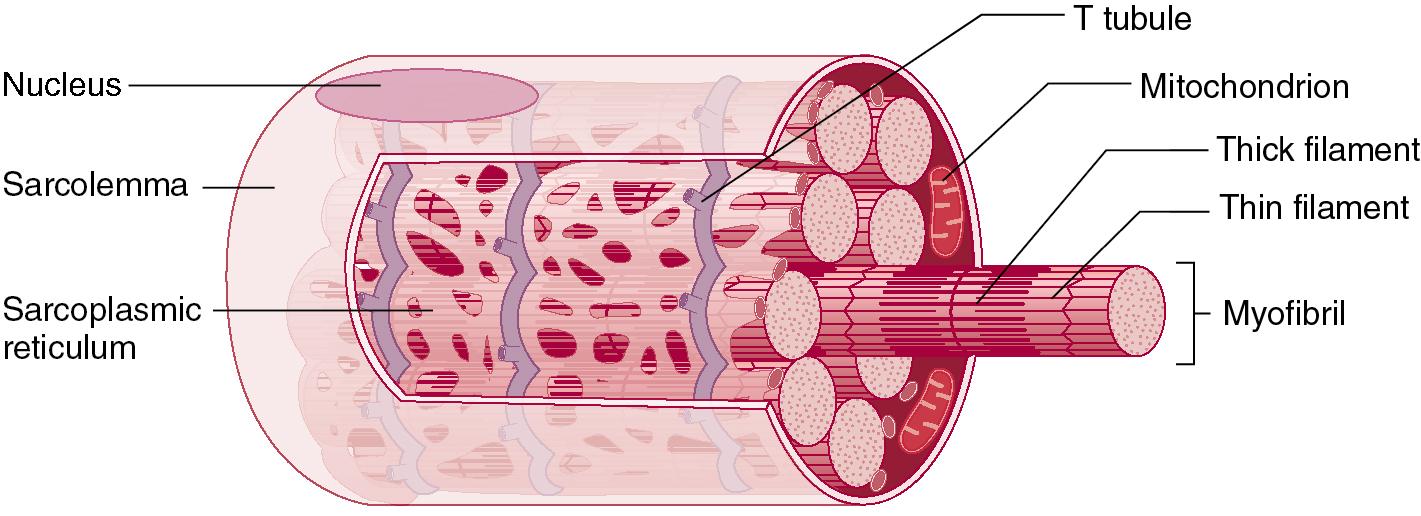
Like most other cells, motor neurons and skeletal muscle cells have a number of organelles, including one or more nuclei, endoplasmic reticulum, ribosomes, and the Golgi complex. Although each of these is essential for proper cell function, the following discussion focuses on those organelles critically involved in movement.
The neuromuscular junction is the meeting point between the peripheral nervous system and skeletal muscle. The neuromuscular junction is a chemical synapse between a lower motor neuron and a skeletal muscle cell ( Fig. 5.4 ).
On the presynaptic side of the neuromuscular junction is the terminal bouton of the lower motor neuron axon.
Synaptic vesicles in the presynaptic lower motor neuron contain the neurotransmitter acetylcholine (ACh).
These synaptic vesicles aggregate at specific sites called active zones.
The nerve and muscle cells are separated by a narrow gap called the synaptic cleft, a complex, amorphously structured extracellular space containing carbohydrates and enzymes.
On the postsynaptic side of the neuromuscular junction is the muscle cell.
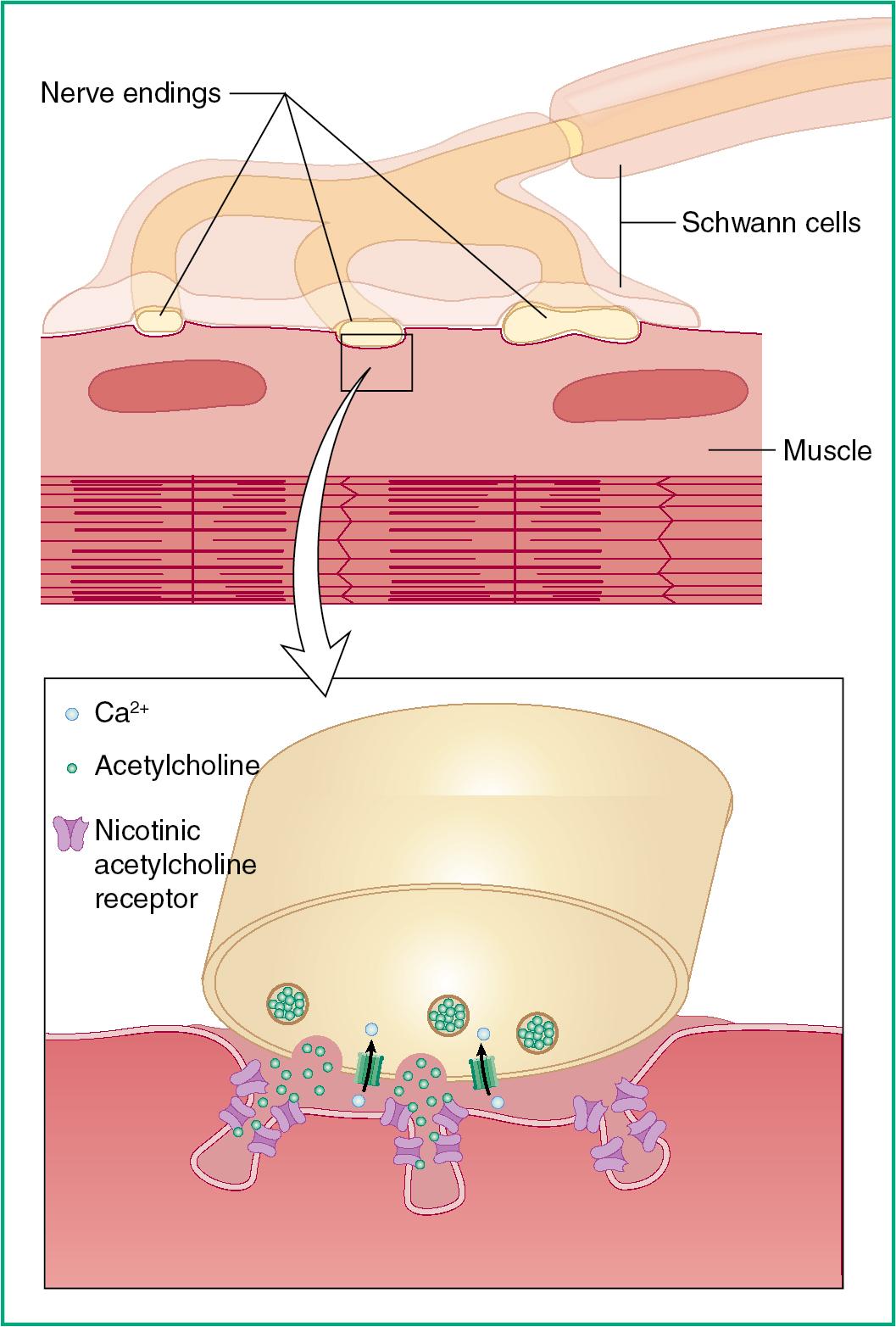
The muscle cell membrane is called the sarcolemma.
At the points where lower motor neurons synapse with muscle fibers, the sarcolemma forms a shallow depression, or synaptic trough, into which the terminal button fits.
At the trough, the sarcolemma invaginates into synaptic folds, forming pits which are located directly under the active zones and are studded with numerous ACh receptors. This area is referred to as the motor end plate.
The sarcolemma also has a system of deep invaginations that topologically extend the extracellular space into the muscle fiber. By means of this system of T tubules, subcellular structures even in the center of the muscle fiber are not far from the extracellular space ( Fig. 5.5 ).
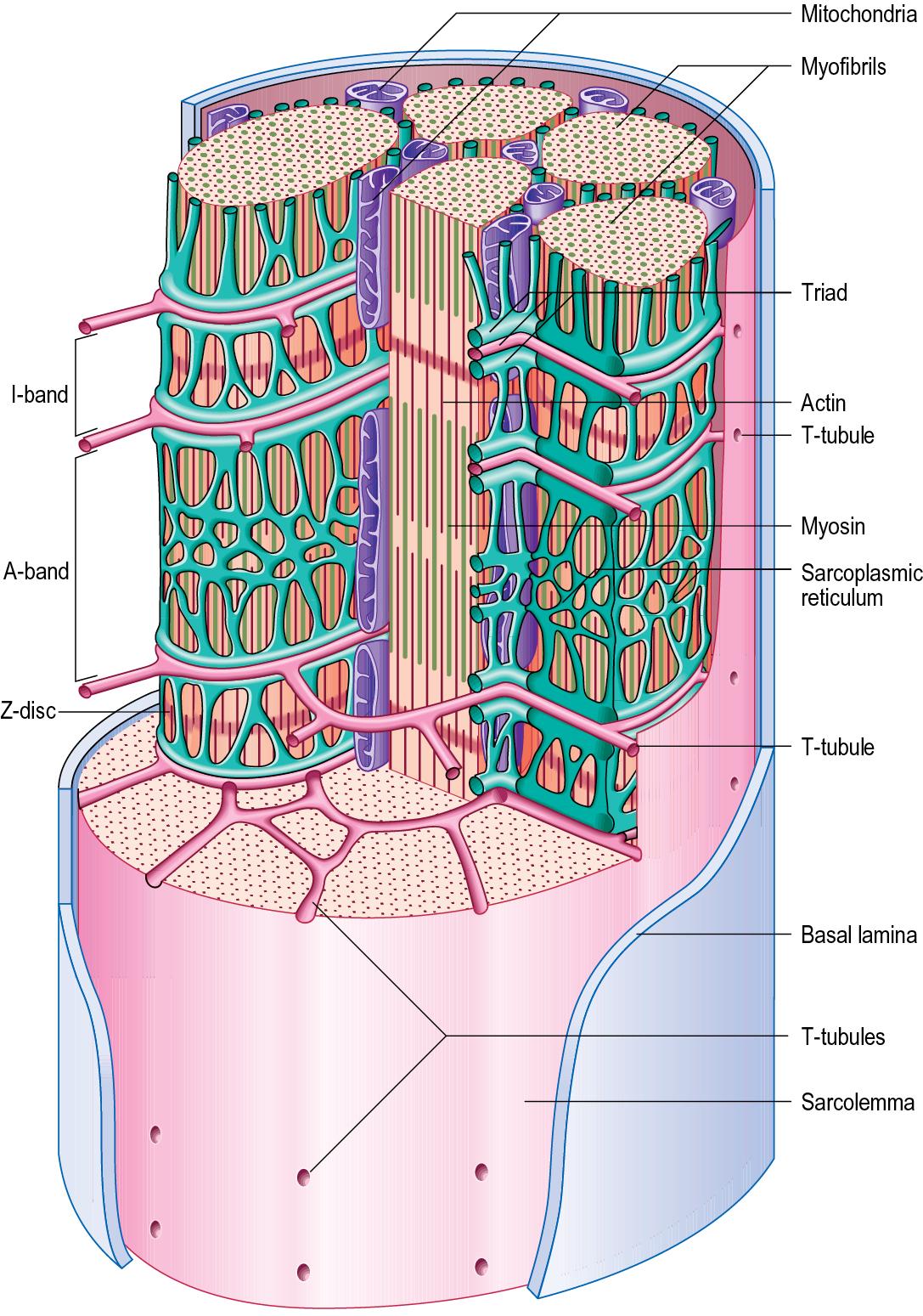
Along with the T tubules, the skeletal muscle fiber contains a structurally and functionally specialized endoplasmic reticulum called sarcoplasmic reticulum (SR), a system of closed membrane pouches (i.e., they do not open to the extracellular space).
These membrane-enclosed spaces are longitudinal in the middle and have lobulated ends called terminal cisternae.
The SR has a high internal concentration of calcium.
When a muscle fiber is viewed under an electron microscope, each T tubule invagination is flanked on either side by a terminal cisterna.
Together, a T tubule and the two terminal cisternae are called a triad.
Triads occur at regular intervals along the long axis of the muscle fiber.
Striated muscle appears striped when viewed under the microscope because of the regular arrangement of its contractile components, which are made up of specialized protein aggregates.
A longitudinal section through a muscle fiber reveals many closely packed parallel myofibrils with alternating light and dark bands or cross striations.
Myofibrils are long, tubular structures with longitudinal axes parallel to the longitudinal axis of the whole muscle cell ( Fig. 5.6 A).
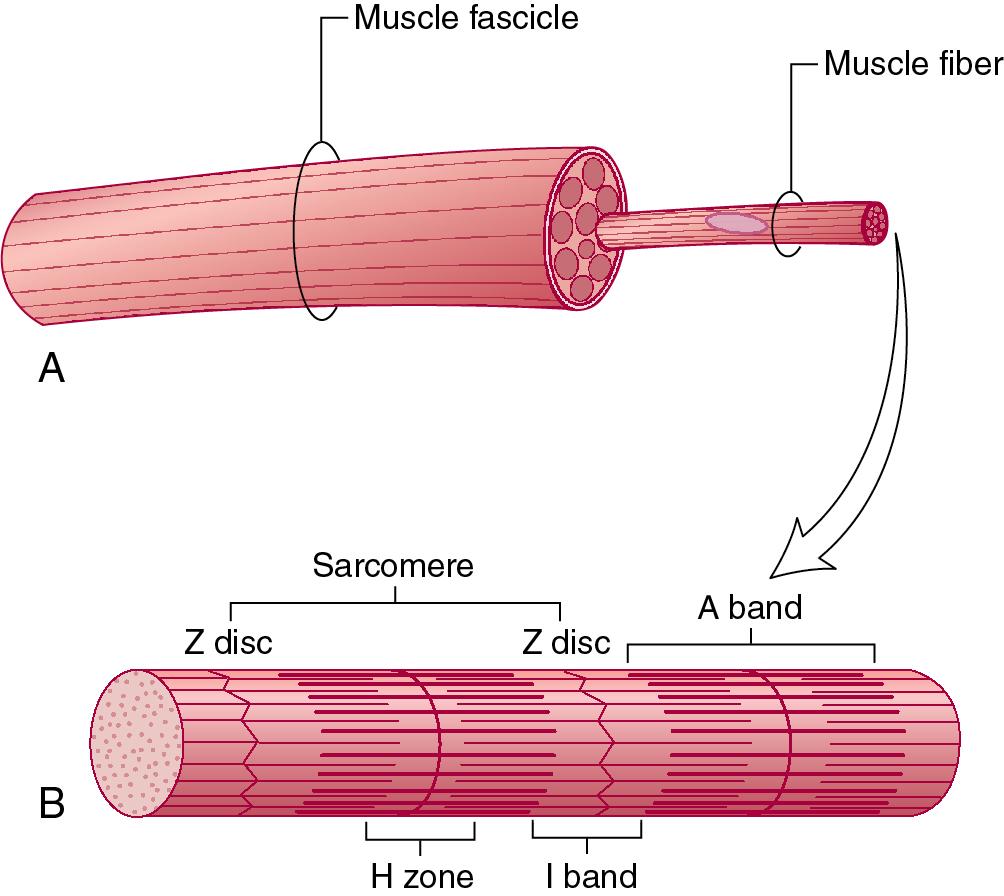
Myofibrils have five main components ( Fig. 5.6 B):
An I band is the light cross striation (cylindrical).
A Z line is a dark line in the center of an I band (disc-shaped).
An A band is the dark cross-striation (cylindrical).
An H band is a lighter cross-striation in the center of the A band (cylindrical).
A M line is a dark line in the center of the H band (disc-shaped).
A sarcomere, a portion of a myofibril between two consecutive Z lines, is the basic functional contractile unit of skeletal muscle. As mentioned earlier, triads occur at regular intervals along the length of the muscle fiber. Each sarcomere has two associated triads, one at each of the I band and A band borders.
Several unique molecules are responsible for the electrochemical events that transmit instructions for movement down a nerve cell axon and across the synaptic clefts that separate upper motor neurons from lower motor neurons and lower motor neurons from skeletal muscle cells. In addition, the molecules of skeletal muscle cells constitute the contractile machinery ultimately responsible for movement.
Motor neurons have many proteins embedded in their cell membranes. Among the most important membrane proteins for neuronal control of skeletal muscle contraction are the channels and ion pumps.
Each synaptic vesicle of a motor neuron terminal contains approximately 10,000 molecules of ACh, the fundamental neuromuscular neurotransmitter that activates skeletal muscle. ACh receptors (AChRs) are found in high concentrations on the sarcolemma, clustered around the mouths of the synaptic folds (see Fig. 5.4 ).
The AChR is a complex protein pentamer embedded in the lipid bilayer of the sarcolemma.
Each receptor has five subunits (two α and one each of β, γ, and δ) that combine to form a central ion channel.
Because the α subunit has the ACh binding site, each ACh receptor can accommodate two neurotransmitter molecules. The five subunits combine to form a central ion channel.
The enzyme acetylcholinesterase (AChE) is associated with the extracellular surface of the sarcolemma via hydrophobic interactions. It is therefore an inhabitant of the synaptic cleft.
Become a Clinical Tree membership for Full access and enjoy Unlimited articles
If you are a member. Log in here